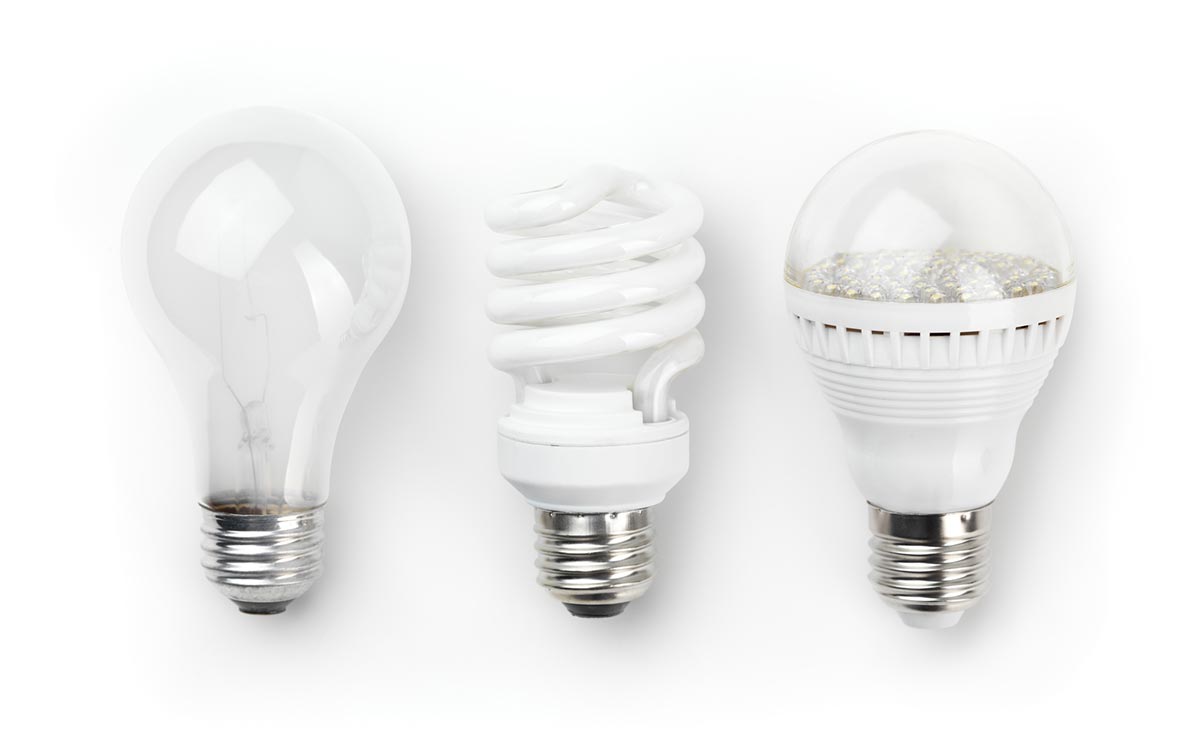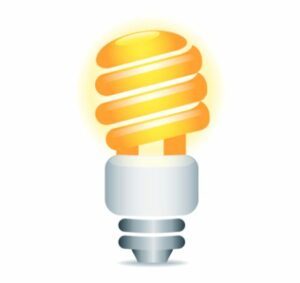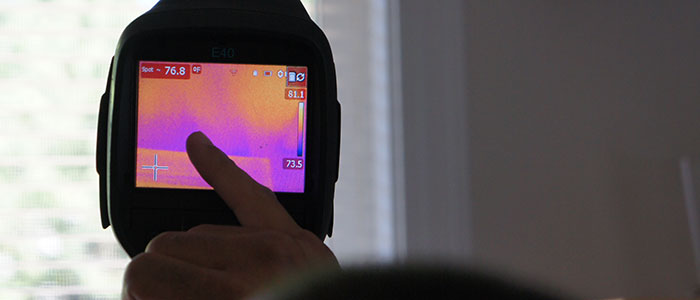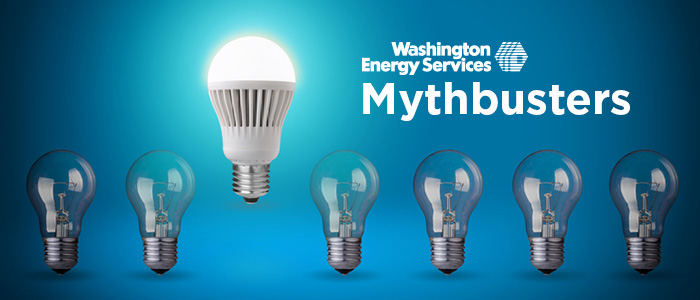
Seeing the light; top 8 questions about the light bulb changeover.
Frequently asked light bulb questions:
1. Which bulbs are discontinued?
40 watt, 60 watt, 75 and 100 watt incandescent bulbs plus the T12 and T8 flourescent tubes used in overhead lighting. The new generation of energy efficient LED, CFL, (HE) high efficiency incandescents and deluxe fluorescent bulbs will fit in your existing fixtures. While it might freak you out to pay up to $7.50 for a light bulb, the payback in energy savings and longevity makes up for that.

2. What will I see in energy savings?
Studies say that changing out 15 standard bulbs for one of the more efficient options will save you $50 per year on your electric bill. * That could be $50 million for Seattle area residents**.
3. What are these new 40 or 60 watt incandescent bulbs at the store?
These are typically labeled HE, for high efficiency. The high efficiency incandescent has a filament that is insulated by a gas to reduce heat loss, but will retain the visual light you are familiar with from current bulbs. These new bulbs will save energy, can be used with a dimmer switch, and provide familiar color.
4. Is this ban of incandescent bulbs only in the US?
No. Governments around the world are supporting this initiative. George W Bush signed the US bill into law in 2007.
5. Why legislate a change in light bulbs?
Huge Energy Savings. Traditional incandescent bulbs waste 90% of their energy producing heat instead of light. While that’s nice for your cat when it sleeps under a table lamp, it’s wasting energy. New bulbs use 28-85% less energy, and last up to 25 times longer. Here’s how the top ones stack up vs traditional incandescent bulbs. *
| Type of Bulb | Energy savings | Lifespan vs old incandescent | Approx. Cost |
| LED | 80% less energy | 25 times longer | $7.50 |
| CFL | 75% | 10x | $4 |
| Halogen | 40% | 3x | $4 |
| High efficiency incandescent | 28% | 3x | $2 |
6. What about light bulbs that are used in grow lights for seedlings?
LED grow lights provide superior performance as they deliver more light output with less energy and heat production, and have a much longer useful life than current fluorescent or incandescent lamps. LEDs can be made in different colors to mimic the ranges of natural sunlight that drive maximum plant performance. These use standard bulb fittings, so they can probably fit into your existing grow light equipment. They come in a variety of wattages.
7. Should I use a CFL (compact fluorescent lamp) or an LED (light emitting diode), they both save energy, so what is the difference?
LED is our strong recommendation, and we suggest you turn down free CFL’s except for use as porch lights.
a. LED’s provide many benefits and prices are coming way down. They last longer than halogen or CFL bulbs, which is why they are used in headlights and TVs.
b.Importantly, LED’s do not have the toxic aspects of the CFL. The CFL bulb, while efficient, contains toxic mercury and disperses unsafe amounts of UV light. You cannot throw away a CFL bulb in your regular trash. Studies by reputable universities have determined that it is harmful to sit under a CFL bulb for extended time as the UV radiation can be detrimental.
c. The quality of light from either LEDs or Halogen bulbs is better than most CFLs. The CFL’s take time to warm up and share their light, plus most types cannot be used in a dimmer. The light that comes from these bulbs is not the same color as your current conventional bulb. It’s harsh… like turn on the lights in a bar at closing time harsh.
8. Are all incandescent bulbs going away?
The regular sizes mentioned are when retailer inventories are depleted, but specialty sizes such as appliance bulbs (for inside of your range hood or refrigerator), decorative fixture bulbs, 3 way bulbs, and other specialty bulbs will still be made.
Washington Energy Services has provided tailored energy saving solutions for Puget Sound area homes since 1957. For the best in energy saving products and services, call 800-398-4663 or click for more information.
* Reference: EnergyStar, Lighting choices to save you money, 2013.
** Based on an estimate of 1 million homes and apartments in Seattle and surrounding area.
Related products
Suggested Reading
- 2016
- AC
- AC Installation
- AC Units
- AFUE
- air conditioing
- air conditioner
- air conditioning
- air conditioning maintenance
- air conditioning service
- air conditioning tune-up
- air duct
- air duct cleaning
- air handlers
- air pollution
- Air Purification System
- air purifier
- Air Sealing
- angie's list
- award
- basement Finishing
- Bathroom remodel
- BBB
- BBB Accredited Business
- before and after
- Best air conditioner
- best filters
- best generator
- best locks
- best water heater
- best window install
- boilers
- bryant
- Bryant AC
- bryant furnace
- bryant heat pump
- christmas lights
- clean air
- clothes drive
- Clothes For Kids
- coat drive
- combi-boiler
- comfort
- community
- Construction
- contractor
- contractors
- Cooling
- Cooling equipment
- Coronavirus Protection
- custom
- daikin
- deals
- discounts
- DIY
- Donation
- Donations
- door hardware
- door installation
- door replacement
- Door Transformations
- doors
- drafty home
- drain cleaning
- Duct Cleaning
- Duct Cleaning Services
- ductless
- Ductless heat pump
- ductless heat pump. mini-split
- Ductless heat pumps
- ductless heating system
- ductless heating systems
- ductless installation
- Ducts
- earth day
- eco friendly
- EER
- election
- electrical inspection
- emergency
- energy
- energy conservation
- energy efficiency
- energy efficiency rebates
- energy efficient AC
- energy efficient air conditioner
- energy efficient home
- energy efficient hvac
- energy efficient HVAC Systems
- energy efficient windows
- energy myths
- energy saving
- energy saving home products
- energy star
- energy tax credit
- environmentally friendly
- exterior doors
- fall
- fall weather
- fiber cement
- fiberglass doors
- filter
- filter change
- financing options
- fireplace
- fireplace insert
- fireplace repair
- fireplace tune-up
- front door
- furnace
- furnace filters
- furnace install
- furnace maintenance
- furnace mileage
- furnace problems
- furnace replacement
- furnace service
- furnaces
- Garage door replacement
- gas fireplace
- gas fireplace inserts
- Gas Fireplace Makeover
- gas furnace
- generators
- going green
- good business practices
- green solutions
- Guardian Maintenance Club
- heat
- heat pump
- heat pump installation
- heat pump maintenance
- heat pump vs ac
- Heat Pumps
- heat pumps maintenance
- heat wave
- Heating
- Heating and Cooling equipment
- heating and cooling systems
- Heating Brands
- Heating Control
- Heating equipment
- Heating System Tuneup
- heatwave
- HEPA filter
- history
- holiday
- home
- home buyer
- home energy
- home energy efficiency
- Home energy efficiency solutions
- home exterior
- home heating
- home improvement
- Home Improvement Rebates
- home improvement repair
- home inspection
- home maintenance
- home maintenance checklist
- home maintence
- home performance
- home protection
- home repair
- home safety
- home upgrade trends
- home upgrades
- home value
- homeowners
- honeywell
- hot water
- hot water heater
- houzz
- how to
- HVAC
- HVAC Contractor
- HVAC Contractors
- hvac system
- IAQ
- indoor air quality
- infographic
- install
- install furnace
- insulation
- intellihot
- interior doors
- kids
- Kitchen face lift
- LED light
- LED lights
- light bulb
- light bulbs
- locks
- mailbag
- maintenance
- march
- membership
- mini-split
- modulating furnace
- money saving
- money savings
- navien
- new door installation
- new home
- New homeowner
- new windows
- news
- pacific northwest weather
- patio doors
- pets
- plumbing
- plumbing inspection
- power
- power outages
- precision tune up
- preventative
- Pro Tips
- Programmable Thermostat
- Programmable Thermostats
- propane
- PSE Award
- PSE Energy
- PUD
- Q & A
- Ratings
- rebates
- refund
- REME Halo
- Remodel
- remodeling hacks
- Replacing Heating System
- reputation
- Safe Home Insulation
- sale
- save energy
- Saving money
- scam
- scams
- seattle
- Seattle Weather
- SEER
- service
- services
- Siding
- Siding replacement
- sliding glass doors
- Smart Home
- Smart thermostat
- smoke
- Solar Attic Fan
- solar power
- Solar Powered Light Strand
- sound
- spring
- standby generators
- storm doors
- summer
- summer fires
- Summer heat
- Summer home
- super service 2016
- tank water heater
- Tank water heaters
- tankless tune ups
- tankless water heater
- tankless water heaters
- tax rebate
- thanksgiving
- Thermostat
- tips
- trends
- tune-up
- upgrade
- upgrade cooling
- upgrade heating
- utilities
- utility rebates
- veterans
- Washington Energy
- washington energy services
- water conservation
- Water Heater
- water heater installation
- water heater maintenance
- water heater repair
- water heaters
- water leak protection
- Wildfire Season
- wildfire smoke
- window
- window energy efficiency
- window install
- window maintence
- window remodel
- window repair
- window replacement
- windows
- winner
- winter
- zone heating
- Air Conditioning
- Air Purifiers
- Cooling
- Doors
- Ductless heat pump
- Environmental
- Fireplace
- Furnace
- Gas fireplace
- Generators
- Heat pump
- Heating
- Home improvement
- How to
- HVAC
- Indoor Air Quality
- Insulation
- News
- Plumbing
- Rebates
- Seattle
- Siding
- Smart Home
- Tank water heaters
- Tankless water heaters
- Tips to save money
- Uncategorized
- Wildfire Season
- Windows

